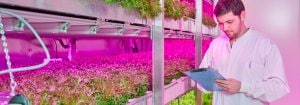Be the first! Get the latest news and updates - Subscribe to our newsletter!
Want to control nitrate levels in leafy greens? Switch on LED grow lights
There is an ongoing discussion about whether nitrates in food are good or bad for people’s health. Some want lower nitrate levels in vegetables, while others believe in the nutritional value of higher nitrate levels. Whatever side of the issue you are on, you may be interested in some new results from Philips lighting Research, HAS School for Agriculture and Wageningen University. By growing leafy greens under LED grow lights in an indoor vertical growing environment, researchers discovered they could decrease or increase nitrate levels in the plants.
Nitrates in vegetables
For decades there has been a discussion about the health risk that nitrate poses for people who consume vegetables. In the past 5-10 years, however, more and more articles have appeared that claim nitrate intake from vegetables is healthy. Nitrate has been shown to have an antimicrobial activity and to enable the body to produce nitric oxide which is believed to play an important physiological role in vascoregulation. That would be beneficial for cardiovascular patients[1] or athletes wanting to enhance their performance.
The Dutch food authorities have recently changed their advice on spinach and high nitrate vegetables[2] and removed their limitation of the daily intake in grams. This is probably due to recent research showing that in general people who eat more vegetables per day are more likely to remain healthy.
Nitrates in fertilizers
Nitrate that is naturally present in food may be viewed more positively, but there is still one aspect of nitrate that remains a concern – the increasing nitrate levels in vegetables and environment due to the misuse of nitrate fertilizers. Nitrates are necessary elements for plant growth, but the more light a crop receives the less nitrates will be stored in the plant’s leaves. Crops grown in the field or in greenhouses receive the same nitrate fertilizer every day, but they receive different levels of light on cloudy days and sunny days, and in winter versus summer. On sunny days there is enough sunlight for the plant to process the fertilizer, but on cloudy days the nitrate cannot be processed and will instead be stored into the plant’s leaves.
In the field or greenhouse, it is hard to apply the ideal combination of fertilizer and light because you cannot control the weather. In a vertical farm or city farm like Philips lighting’s GrowWise Center, however, our high precision irrigation system delivers the ideal combination of nutrition and our LED grow lights apply the optimal amount of photosynthetic light that will avoid the plant from taking up excess nitrate.
Controlling nitrates in a city farm
Researchers at Philips lighting have also been looking at how to use LED grow lights to further control nitrate levels in indoor grown vegetables. A study carried out by Philips lighting Research, HAS School for Agriculture and Wageningen University aimed to decrease nitrate levels in leafy greens. The results showed that LED grow light recipes can significantly reduce nitrate levels of vegetables grown in a city farm.
In the research trial, a specific pre-harvest LED lighting strategy was used a few days before harvest to deplete the nitrate accumulated in the leaves during the growth period. The photoperiod was increased by up to 24 hours/day and could also be combined with a change in the light spectrum depending on the crop. Together with an appropriate irrigation strategy and climate settings for optimal plant growth, the nitrates were significantly reduced using this recipe. The strategy was applied to various types of lettuces, spinach and rocket cultivars. Most trials were done in our GrowWise Research Center but we also did a comparative test with leafy greens grown in a greenhouse. Read our blog on “How different growing environments can influence nitrate levels in leafy greens” for more about this topic.
The results of this research are very promising because it shows that LED light recipes can open new opportunities for growers in city farms. They have more flexibility in producing leafy greens that are tailored to their consumers and local requirements.

At the Philips GrowWise Research Centre, our experts study the conditions needed to optimise plant growth. This includes the effect that different types of vertical farming lighting, climate systems, nutrition, irrigation, sensors and data collection can have on plant health and quality. It enables us to develop growth recipes for vertical farmers that will produce specific characteristics and create healthier plants with higher yields.
For additional information about this topic, please contact Thijs van den Bergh at thijs.van.den.bergh@signify.com.
Related articles
Contact us
Contact certified partners
Philips products are sold through a global network of certified partners. Find partners in your region for more information about Philips LED grow lights.
Contact Philips
What are the best LED grow lights for your situation? We are here to help. Please use our form to submit your request.
Subscribe to newsletter
Keep up to date about Philips LED lighting in horticulture by subscribing to our newsletter.
Join our team
Interested in discovering your recipe for growth and joining our team? Take a look at our career page for more information.
Interested?
Learn more about LED lighting in horticulture by reading our latest articles and case studies.



